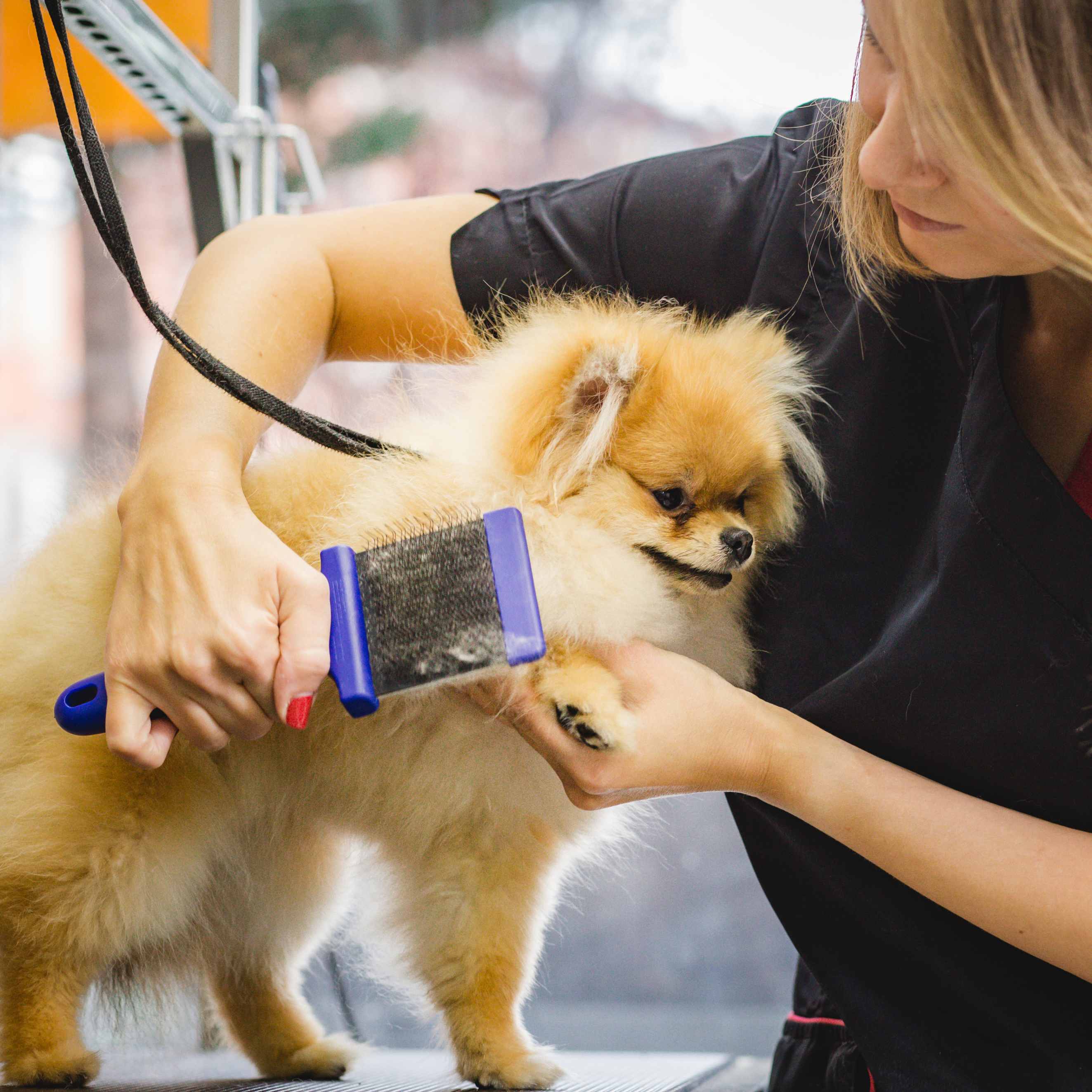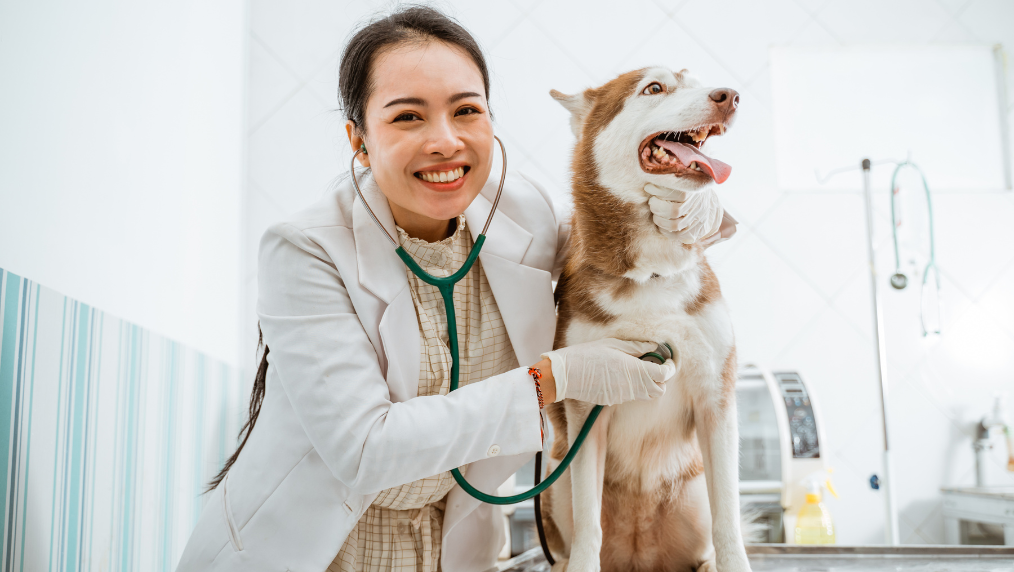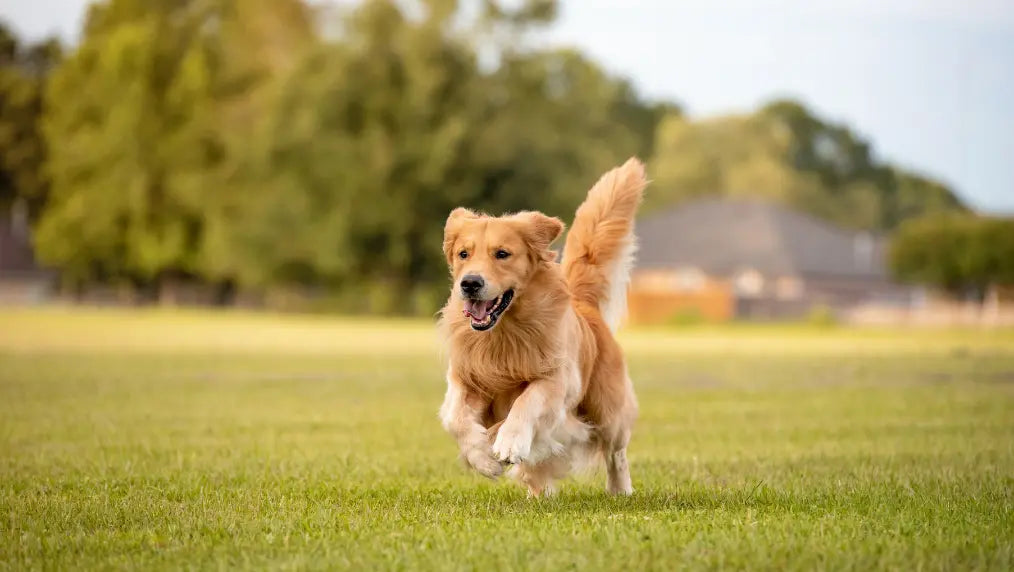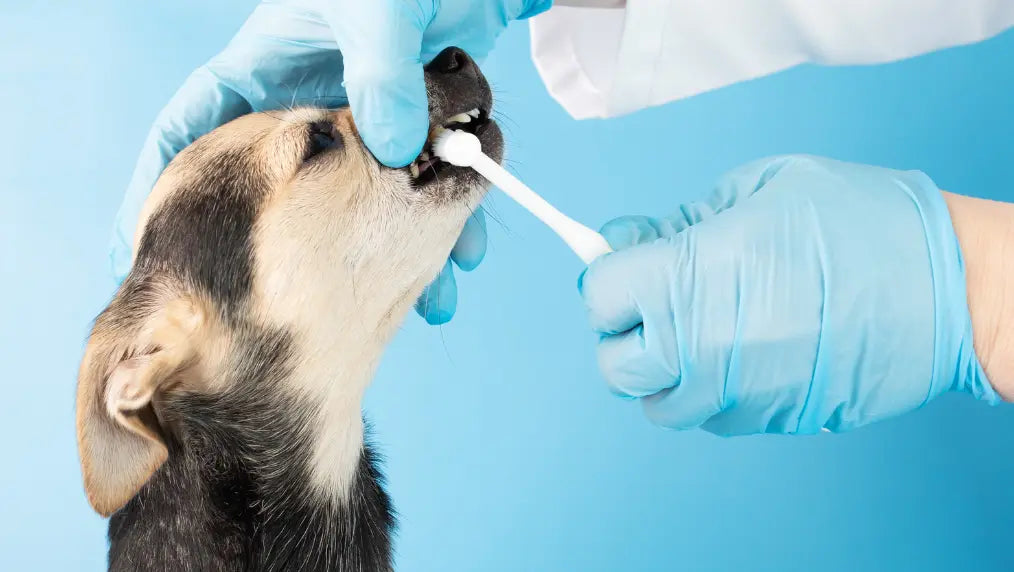Brushing your dog regularly not only keeps their coat looking good, but it also helps release dead hair and skin follicles, helping you manage dog shedding season, remove mats, and distribute the natural oils in the skin to keep your dog healthy. Dog grooming is important for all breeds, not just those with long hair. Short haired dogs and shedders also require regular dog grooming and brushing.
We all want our pets to look and feel their best, and that includes regularly brushing their fur. Much like the perfect dog collar or dog crate, finding the best dog brushes or combs is an important and a highly personal decision based on your pet’s specific needs.

Buying the Right Dog Grooming Brushes and Tools
We always recommend investing in quality tools. Not only will they last the lifetime of your pet (if the tools are well cared for) but well-made combs and brushes will have smooth, finished teeth or tines that will glide smoothly through the coat and not cause damage as you work.
We’ve culled the best brushes and combs for different dog coat types to help you identify the most appropriate one for your pet. If you’re still not sure what to pick for your pet, talk to your breeder or groomer for tool recommendations.
Breed and personality determine little. Ideally, one will choose the proper dog brush and comb for your dog’s coat type. Always gather your supplies in advance so that you won’t have to go looking for them in the middle of the grooming process. Depending on your dog’s coat, and in addition to shampoos and grooming products, you will need the following:
-
bristle brush
-
comb
-
curry brush or rubber dog brush
-
mat and tangle remover
-
pin brush
-
scissors
-
shedding blade
-
slicker brush
Also Read - Why Puppies Bite & How to Prevent It
What to Consider Before Buying Grooming Tools, Dog Brushes and Combs
As dog owners, you can easily examine your dog’s coat and determine the following:
-
Does your dog have long or short hair? Most dogs do well with slicker brushes, while a rake can be handy on double coated dogs, long-haired dogs (think Malamutes). Rubber curry combs are a good choice for dogs with short hair, such as Pugs, according to Conner.
-
Is your dog’s hair prone to tangling? You will likely need to tackle stubborn knots with a combination of both combing and brushing with a slicker brush. “The brush removes the tangle, while the comb finds anything you missed,” Conner says.
-
How much does your dog shed? Deshedding brushes can really cut down on loose hair. It’s important, however, to use it with a gentle touch, so you don’t irritate your dog’s sensitive skin. There are great brushes for a dog with a double coat or to collect loose hair.
-
Does your dog have an undercoat? Rake-style dog brushes are very effective at removing shedding undercoat. For longer coats, look for brushes with longer teeth. For shorter coats, smaller teeth.
Now that you have a solid understanding of your dog’s fur and grooming needs, you’re prepared to shop for the best dog brushes or combs.
Types of Brushes and Combs for Dogs

-
Slicker Dog Brushes
Slicker dog brushes gently work through snarls and get rid of loose and dead hair. They usually have fine wires spaced closely together on a flat brush surface, with shorter teeth for shorter coats and medium or long teeth for medium or long coats. As many breeders’ “go to” brush, slicker dog brushes tend to work well for most breeds. They are also great at removing loose hair and being used during regular grooming.
Perfect for: Most dog breeds.
-
Dog Pin Brushes
Dog pin brushes look similar to what you might use on your own hair. They usually have a rounded shape and wires with plastic balls on the end. A very popular choice with pet parents, they can be useful for separating, stretching and straightening hair after a bath.
The PRIDE+GROOM ONLY BRUSH is a well-made brush that is designed to last for a long time and is suitable for a wide range of dogs in all shapes and sizes. With stainless steel pins and a solid wooden handle, your furry friend will love regular brushing. You may find that you also want to use a slicker and/or a comb in addition to this brush to pick up strands that have been shed (slicker) or to tackle mats in fur more directly (comb), but it also helps with the aforementioned issues.
Perfect for: Show dogs with curly coats (such as Poodles) or long coats (such as Lhasa Apso).
-
Dog Bristle Brushes
Short-haired dogs tend not to struggle with knots, and so usually only need a light brushing. Dog bristle brushes have tightly packed groupings of natural or nylon bristles that sweep away loose fur and distribute their hair oils. If you’re looking for a brush that gives you options, the PRIDE+GROOM double sided ONLY BRUSH is a smart choice. Use the pin side for fluff drying, and the bristle side for smoothing, shining and softening your dog’s coat.
When you're trying to obtain a shiny coat or smooth coat, a bristle brush may be just what you need.
Perfect for: Smooth-coated dogs (which can also mean any dog with short hair), such as Dalmatians or Dobermans.
-
Dog Combs
Metal dog combs are first-rate for tackling unruly coats. Use a comb after brushing with a slicker dog brush. A dog grooming comb will show which areas need more brushing. Start with the wider spaced teeth, and then move to the narrower teeth, making sure you comb every part of the dog, particularly anywhere there is friction. If you find a knot, go back with the brush to get any tangles out, and then recheck with the combs.
Most combs are made of stainless steel and are perfect at removing loose hairs and matted fur during your home grooming session. Grooming sprays, like PRIDE+GROOM’s LEAVE IN conditioner, can help remove difficult tangles.
Perfect for: Dogs with medium to long coats, such as Golden Retrievers and Huskies.
-
Dog Deshedding Brushes
Do you find yourself vacuuming nonstop? Is there collected hair always in your trash bin? Give a dog deshedding brush a shot. It won’t prevent or clear away mats, but it’s effective at gathering up dead and loose hair. But be careful! A delicate touch is key, especially on your dog’s spine, shoulders and hips.
Ideal for short-hair dogs, this style brush may also be used every few days on dogs with longer coats (such as Malamutes) during shedding season, in conjunction with a good slicker dog brush and comb. Used too vigorously, it can seriously irritate the dog's skin however. This is not meant for daily brushing.
Not keen on the idea of using this kind of tool? Try bathing your shedding dog with PRIDE+GROOM’s THE SHEDDER shampoo to eliminate more shedding outside of the bath.
Perfect for: Smooth-coated dogs, such as Labrador Retrievers or Beagles.
-
Curry Dog Brushes
Curry brushes, like THE BATH BRUSH by PRIDE+GROOM, are made of cushy rubber or plastic that loosens hair and dirt. They have bendy little nubs that are gentle enough to get right down to the dog’s skin without poking them. Curry combs are dandy on smooth-coated dogs, and work really well in the bathtub. Suds the dog up, and curry away lots of dead hair. However, they won't remove tangles on medium- to long-coated dogs.
This brush is perfect to remove dead hair on sensitive dogs. They are also great for giving your dog a gentle massage while stimulating and releasing natural skin oil and removing loose fur.
Perfect for: Smooth-coated pups, such as Doberman Pinschers.
-
Dog Brush Gloves
Give your pooch a spa treatment with the right grooming glove. They typically come in many different sizes for a perfect fit! Designed with nodules on the palms, dog brush gloves provide a similar sensation to petting and can be an outstanding option for dogs who dislike being groomed. A lot of dogs would enjoy a rub down with these gloves. They will help remove some dead and shedding coat, but don’t count on them to really reduce shedding or remove tangles. In addition to ease of use, pet parents love that they allow more pressure control than with a brush.
Perfect for: Smooth- or medium-coated dogs, such as Dachshunds or German Shepherds.
Brushing Shouldn’t Replace Professional Grooming

The process of keeping your dog well-groomed should revolve around health, wellness, safety, and convenience for both you and your four-legged friend.
If you don't want to deal with brushing your dog and maintaining their coat daily, a professional dog groomer can help make your life much easier! Professional grooming is also beneficial to a dog’s health in addition to their coat. Having your dog professionally groomed can save you time and energy. It takes a lot of care and patience to groom a dog, especially a fluffy one, a puppy, or one with behavioral issues.
FAQ:
1. Should you brush your dog before or after a bath?
Both, but always brush your dog before a bath. If their hair has any knots, water will make it more difficult to remove mats and tangles. Even if your dog’s hair is not tangled, it can be helpful to brush it thoroughly before the bath to remove loose hair and other items that tend to collect on our canines, like leaves and twigs.
After the bath and once your dog's hair is dry, it's also beneficial to brush through again to ensure the coat is untangled and to help collect hair that's been shed. Using THE LEAVE IN by PRIDE+GROOM on wet or dry hair is beneficial with any comb or brush to remove tangles and keep the coat feeling it’s best.
2. Do dogs like being brushed?
Try a brush on your arm before you use it on your dog and see how it feels. Brushing is a pleasurable bonding activity that many dogs enjoy, especially when brushing is introduced early in puppyhood. If your dog doesn't like being brushed, create good associations with this necessary chore by giving them lots of tasty treats and praise during brushing sessions. Be sure to brush regularly to avoid mats and tangles, as trying to brush a tangled coat is uncomfortable and even painful for the dog. If your dog is too matted to brush, seek help from a professional groomer.
3. How do you get dog hair out of the brush?
You can use your fingers to remove dog hair from the brush or a straight metal comb. Simply insert the comb at the base of the brush beneath the hair and lift it off the bristles in one large clump.
Also Read - 10 Reasons Why You Should Foster a Pet
Conclusion
The right dog brush for you and your dog will make grooming more pleasant for both of you. Whether you have dog fur, smooth coats or matted fur on your hands, there is a tool for you. When you find a brush that’s effective and comfortable to use, brushing your pup can evolve from being just a task to a bonding activity.





